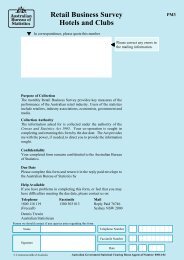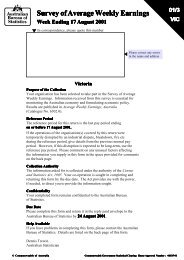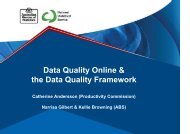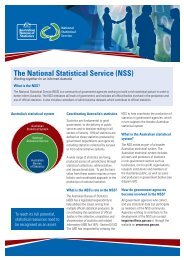SAE Manual Sections 1 to 4_1 (May 06).pdf - National Statistical ...
SAE Manual Sections 1 to 4_1 (May 06).pdf - National Statistical ...
SAE Manual Sections 1 to 4_1 (May 06).pdf - National Statistical ...
Create successful ePaper yourself
Turn your PDF publications into a flip-book with our unique Google optimized e-Paper software.
A Guide <strong>to</strong> Small Area Estimation - Version 1.1 05/05/20<strong>06</strong><br />
o<br />
o<br />
o<br />
This guide aims <strong>to</strong> give advice for <strong>National</strong> <strong>Statistical</strong> Centres and regional offices on<br />
how <strong>to</strong> advise, respond <strong>to</strong> and incorporate small area estimates in<strong>to</strong> their work, so<br />
they can apply simple models themselves and know when <strong>to</strong> draw on<br />
methodological skills for more complex models.<br />
A second volume of the manual will cover the more technical aspects of small area<br />
estimation and will be primarily aimed at methodologists and technical analysts<br />
involved in producing modeled small area estimates. The technical manual will cover<br />
in more detail the methodological and statistical issues that arise in small area<br />
estimation.<br />
The content of this manual contains material on the application of basic statistical<br />
models. The manual therefore assumes the reader has a basic familiarity with the<br />
theory and application of such models. Some parts of the manual contain references<br />
<strong>to</strong> somewhat more advanced methods. In such instances warning boxes strongly<br />
recommend <strong>to</strong> the reader that further methodological advice should be obtained<br />
from Methodology Division (ABS) before applying such techniques.<br />
What it is - A Guide <strong>to</strong>:<br />
o<br />
o<br />
o<br />
o<br />
o<br />
o<br />
what issues need <strong>to</strong> be thought through before undertaking a small area exercise,<br />
the methods and techniques available in small area estimation, the relative<br />
advantages and disadvantages and assumptions involved in each,<br />
who <strong>to</strong> talk <strong>to</strong>, who has implemented specific approaches in<strong>to</strong> practice already and<br />
where <strong>to</strong> find relevant documentation,<br />
the trips and traps of putting various techniques in<strong>to</strong> practice,<br />
how <strong>to</strong> best measure the reliability of small area predictions,<br />
how <strong>to</strong> detect model miss-specification and what diagnostics are available for<br />
assessing the overall quality of small area estimates.<br />
What it is not<br />
o<br />
An up-<strong>to</strong>- date encyclopedia of all the literature on small area techniques. The focus<br />
of this manual is much more on the practice of small area estimation in the<br />
production of government statistics. Compiling and maintaining an up-<strong>to</strong>-date<br />
summary of the technical literature would be highly resource intensive as the field is<br />
relatively new and rapidly evolving. It would also make it more difficult for the<br />
practitioner <strong>to</strong> access.<br />
Finally, we emphasise that this manual has been written under the assumption that the<br />
primary goal of small area data users is <strong>to</strong> obtain descriptive statistics of the relative<br />
characteristics of small areas rather than obtain the form of some dynamic structural<br />
process which generates those small area characteristics. The manual is therefore<br />
premised upon a descriptive framework for the ultimate decision making objectives,<br />
even though analytical methods are used <strong>to</strong> construct the models used <strong>to</strong> predict those<br />
small area characteristics. In other words, we assume users are primarily interested in<br />
the predictions from those models, not just the form and structure of the models per se.<br />
Australian Bureau of Statistics 8








